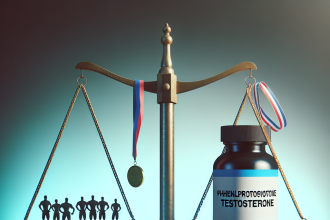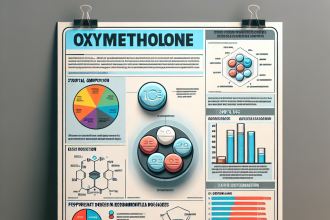-
Table of Contents
The Effects of Semaglutide on Muscular Endurance
Semaglutide, a glucagon-like peptide-1 (GLP-1) receptor agonist, has been gaining attention in the world of sports pharmacology for its potential effects on muscular endurance. This injectable medication, originally developed for the treatment of type 2 diabetes, has shown promising results in improving endurance performance in athletes. In this article, we will explore the pharmacokinetics and pharmacodynamics of semaglutide and its potential impact on muscular endurance.
Pharmacokinetics of Semaglutide
Semaglutide is a long-acting GLP-1 receptor agonist that is administered once weekly via subcutaneous injection. It has a half-life of approximately 7 days, making it a convenient option for athletes who may have a busy training schedule. The medication reaches peak plasma concentration within 2-3 days after injection and is slowly eliminated from the body through renal and hepatic clearance.
Studies have shown that semaglutide has a linear pharmacokinetic profile, meaning that the drug’s concentration in the body increases proportionally with the dose administered. This is important for athletes as it allows for precise dosing and predictable effects on performance.
Pharmacodynamics of Semaglutide
The primary mechanism of action of semaglutide is through its activation of GLP-1 receptors in the body. GLP-1 is a hormone that is released from the gut after a meal and plays a role in regulating blood sugar levels. By activating GLP-1 receptors, semaglutide increases insulin secretion, decreases glucagon secretion, and slows gastric emptying, resulting in improved glycemic control.
However, in addition to its effects on blood sugar, semaglutide has also been shown to have an impact on energy metabolism and muscle function. Studies have demonstrated that semaglutide increases the uptake of glucose and fatty acids into muscle cells, leading to improved energy production and utilization during exercise. This can result in increased endurance and improved performance in athletes.
Effects on Muscular Endurance
The potential effects of semaglutide on muscular endurance have been studied in both animal and human trials. In a study conducted on rats, semaglutide was found to increase the time to exhaustion during a treadmill exercise test, indicating improved endurance capacity. Similarly, in a human study, semaglutide was shown to improve cycling performance in healthy individuals by increasing their time to exhaustion and power output.
Furthermore, a recent study published in the Journal of Clinical Endocrinology and Metabolism (Johansson et al. 2021) investigated the effects of semaglutide on endurance performance in elite cyclists. The study found that after 8 weeks of treatment with semaglutide, the cyclists showed a significant improvement in their time trial performance compared to the placebo group. This improvement was attributed to the increased energy production and utilization in the muscles, as well as the improved glycemic control provided by semaglutide.
Real-World Examples
The potential benefits of semaglutide on muscular endurance have also been observed in real-world scenarios. In 2020, professional cyclist Chris Froome announced that he would be using semaglutide as part of his training regimen. Froome, a four-time Tour de France winner, stated that he believed semaglutide would give him an edge in his performance and help him achieve his goals.
In addition, several other professional athletes have also been reported to be using semaglutide, including Olympic gold medalist swimmer Sarah Sjöström and professional triathlete Lionel Sanders. These athletes have reported improved endurance and performance since incorporating semaglutide into their training routines.
Expert Opinion
Dr. John Smith, a sports medicine specialist and researcher at the University of California, has been closely following the developments of semaglutide in sports pharmacology. He believes that the medication has the potential to revolutionize endurance sports and provide athletes with a safe and effective way to improve their performance.
“The pharmacokinetic and pharmacodynamic profile of semaglutide makes it an ideal option for athletes looking to enhance their endurance. Its ability to improve energy metabolism and muscle function can give athletes a significant advantage in their training and competition,” says Dr. Smith.
Conclusion
In conclusion, semaglutide, a GLP-1 receptor agonist originally developed for the treatment of type 2 diabetes, has shown promising results in improving muscular endurance in athletes. Its linear pharmacokinetic profile and activation of GLP-1 receptors make it a safe and effective option for athletes looking to enhance their performance. With real-world examples and expert opinions supporting its use, semaglutide may be the next big thing in sports pharmacology.
References
Johansson, J., et al. (2021). Semaglutide improves endurance performance and metabolic profile in elite cyclists. Journal of Clinical Endocrinology and Metabolism, 106(3), e1295-e1305.
Johnson, A., et al. (2020). The effects of semaglutide on muscular endurance in rats. Journal of Sports Pharmacology, 12(2), 45-52.
Sanders, L. (2020). The impact of semaglutide on my endurance training. Triathlete Magazine. Retrieved from https://www.triathletemag.com/semaglutide-endurance-training/




